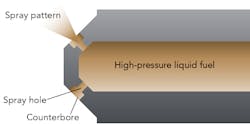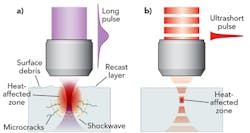Development addresses need for laser micromachining accuracy
MIKE LERNER
In July 2012, the U.S. Department of Energy (DOE) issued a $3.7 million grant to a consortium of companies to develop nascent ultrafast-pulse (UFP; also known as ultrafast) laser technology to build a next-generation manufacturing process for automotive fuel injectors.
The objectives of the grant were ambitious: to research and develop a manufacturing process that was 25% more efficient, with half the cycle times of the standard manufacturing process at the time and that could deliver injectors that delivered as much as 10% better fuel economy than existing gas direct injection (GDI) parts (FIGURE 1).
The grant was a part of a larger government effort to foster "innovative manufacturing technologies," targeting new development of new manufacturing tools, techniques, and processes to help U.S. manufacturers "dramatically increase the energy efficiency of their operations and reduce costs."
Attempts at commercialization
At the time, UFP lasers with pulse widths in the femtosecond regime were more the stuff of science experiments than industrial use (FIGURE 2). In 1987, Dr. Bill Clark pioneered commercial UFP laser commercialization with products for the scientific instrumentation market. His company, Clark-MXR (Dexter, MI), went on to develop the first femtosecond laser for micromachining that could operate in an industrial environment. But as Clark told ILS in a 2014 interview, "that architecture was a decade ahead of its time."
In 2006, Extrude Hone Laser Technologies (Irwin, PA) and General Atomics (San Diego, CA) produced a laser-based diesel fuel nozzle drilling system for the Department of Defense using a diode-pumped solid-state (DPSS) nanosecond laser in the green spectrum (532nm) for this application.
By 2012, femtosecond lasers were beginning to be used for corrective vision applications, but these lasers were used a few times a day in an office environment, not 24/7 in a factory.
The promise of athermal machining
A femtosecond is a quadrillionth of a second-pulsing light faster than a part can absorb heat. The promise was heatless machining, also known as athermal ablation—the ability to remove tiny specks of material with no thermal damage at extraordinary speeds, making new GDI spray hole designs possible.
Machining at the speed of light not only promised to enable injector designs to be cost-effectively machined, it was also hoped that the process could remove one of the most expensive and time-consuming challenges in a precision manufacturing process—post-processing to remove defects.
"Energy efficiency is expected to increase by 20–25% and cycle time could decrease substantially," the DOE wrote. "No consumables are required, which reduces materials costs and energy associated with their production. In addition, this process will eliminate post-production and its associated chemicals use. This technology could have broad impacts in diverse manufacturing sectors."
Traditional methods
The legacy technology used for fuel injector machining was electric discharge machining (EDM), which works by eroding material in the path of electrical discharges that form an arc between an electrode and a tool. The existing manufacturing process, electromechanical discharge machining, was slow, expensive, and involved the use of multiple chemicals to drill the holes and to remove the defects from melting, burring, and recast that come from the heat involved in the process.
"Traditional machining platforms are poorly suited to produce small parts with high accuracy requirements," the DOE said. "The current machining methods are often too large, too inflexible, and lack the necessary precision to manufacture parts with complex shapes or micron-sized features."
Success factors
GDI spray nozzles are about 200μm in diameter, about the same diameter as a human hair. Edge quality, surface quality, circularity, and taper are among the dimensions that, when properly controlled, can deliver more combustion with less fuel.
Another challenge faced by automakers was the ability to control the part during the manufacturing process. The laser would only be as precise as the motion control system used, and creating a reliable, repeatable machine capable of micron-level accuracy represented a major milestone. "Combining a laser with high-precision manipulators would automate and therefore expedite the machining process," the DOE said.
The solution
The companies sponsored by the DOE to create a new manufacturing process for fuel injectors included Microlution (Chicago, IL), which builds micromachining platforms optimized for high-precision applications for a rapidly miniaturizing world.
Microlution built a micromachining workstation with an integrated UFP laser (FIGURE 3). The workstation was tasked to control the control part movement very precisely (to ensure micro-scale accuracy). Furthermore, the system was to fully integrate the control of three key technologies: 1) the machine motion, 2) the UFP laser, and 3) an advanced 5D scanner. Not only would the platform need to control the blank fuel injector part, it would also need to ensure stability that would not disturb a historically very delicate laser beam in a production manufacturing environment. Thermal and inertial stability were big keys to achieving high process capability index (CPk) production standards over days, months, and years.
Successful results
Fast-forward to 2015 and the DOE issued a report on the project, stating that the team "has successfully adopted the technology to make GDI injectors." The DOE reported on the following program goals:
"Consequently, completion of the project will ultimately result in a manufacturing method offering reduced process steps and energy consumption for hard-to-machine materials across multiple markets," the DOE said. "Microlution will focus on platform development applications relevant to the electronics and biomedical industries."
This is a success story not only of public-private partnership—it is also a story of the commercialization of UFP lasers for industrial use. Clark-MXR was among the first to recognize the potential of UFP laser micromachining to improve manufacturing processes. It took many years to find a "killer app" for UFP lasers, and to develop a system that could achieve the application in a manufacturing environment.
Continuous improvement
The technology used to create a new generation of fuel injectors has been adopted by multiple auto parts makers around the world. Even more efficiency has come through integrated pre- and post-part measurement to validate part accuracy, and through the integration of advanced robotics and automation.
In addition, as the DOE predicted, the technology has been adopted by other industries, including medical device manufacturing and aerospace applications.
This history is a very good example of how UFP lasers are making their way from the lab into 24/7 industrial applications. It also accentuates the need for micron-level machine accuracies to take full advantage of the precision made possible by the laser source.
MIKE LERNER([email protected]) is the Head of Sales, Laser, at Microlution, Chicago, IL; www.microlution-inc.com.


